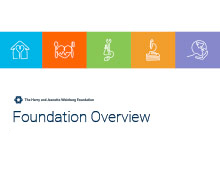Each summer, more than 180,000 kids, teens, and young adults gather at Jewish camps around the country to create new friendships, make lasting memories, and deepen their connection with the Jewish community. It’s a rite of passage that has provided generations of campers and staff with a sense of pride in their Jewish identity. But for those with disabilities, attending Jewish camp was not always an option.
In 2018, the Weinberg Foundation and Foundation for Jewish Camp (FJC) set out to change that through a multiyear partnership called the Yashar Initiative. Through Yashar — a Hebrew word meaning both “level” and “integrity” — the Foundation and FJC aimed to (1) increase the number of campers and staff with disabilities who could participate in Jewish camp; (2) enhance their camp experience through infrastructure improvements and training; and (3) promote a broader culture of inclusion at Jewish camp.
In total, Yashar supported 46 camps across the country, including 23 day camps and 23 overnight camps, serving youth with intellectual, developmental, physical, and sensory disabilities. A recent evaluation of Yashar reinforced the magnitude of its success, which is far-reaching and ongoing.
“This initiative has helped ensure all children — regardless of ability — have access to this formative part of a Jewish upbringing,” said Jon Hornstein, who leads the Foundation’s grantmaking focused on the U.S. Jewish community. “Yashar not only benefited the camps that received direct funding, but also advanced the field by identifying best practices for inclusion and training for staff.”
Promoting camp accessibility and staff training

Accessible amphitheater and sports pavilion at two Yashar camps. Photos courtesy of Foundation for Jewish Camp.
Funding for the Yashar initiative supported strengthening camp infrastructure and training, a combination that greatly contributed to its success. Infrastructure improvements included renovating cabins and play spaces — i.e., playgrounds, pools, and areas for gathering — to be more accessible; developing sensory spaces to better the experience of campers with disabilities; and increasing accessibility at communal buildings and areas for gathering such as dining halls and infirmaries.
The initiative also aided camps in advancing best practices in accessibility, including offering inclusion training for all staff — not just those focused on inclusion — to ensure everyone is equipped to work with each camper. Training included sessions on conflict resolution, problem solving, and building communication skills; caring for campers with specific needs; and breaking down stigmas related to individuals with disabilities. An additional 140 camps that did not directly participate in Yashar also were able to have their staff attend training. As one camp staff member said, “If an inclusion counselor is out, anyone can jump in. Everyone is an inclusion counselor.”
Key insights from the evaluation
The following are just some of the Yashar initiative’s accomplishments:
- Camps are successfully providing campers with disabilities with positive experiences. Parents of all campers were asked if their child felt a sense of belonging at camp as a result of the initiative. The evaluation reported no statistically significant difference between responses from parents with children who had disabilities and parents of children who did not, indicating a strong culture of inclusion.
- Yashar camps are better prepared to accommodate more campers with disabilities who have a broader range of needs. With multipurpose spaces and amenities — including sensory rooms, paved paths, more physically accessible bunks, and ramps — camps are now able to welcome more campers with disabilities. Between 2022 and 2023, camps saw an 8% increase in the number of campers with disabilities served. They also hired part- or full-time inclusion and camper-care staff, which allowed for better meeting the needs of youth with disabilities, enabling them to have a more successful camp experience. From 2021 to 2023, overnight camps — both those participating in Yashar and others that took advantage of inclusion training provided through the initiative — increased the number of inclusion professionals by nearly 375%. At day camps, that number rose by 97% over the same period.
- Yashar infrastructure improvements sent a powerful message to all campers about inclusion at Jewish camps. The vast majority of capital projects involved creating accessible and inclusive multipurpose spaces, such as splash pads, ropes courses, or zero-entry pools (which have a sloped entrance into the water rather than stairs or a ladder). Investing in these structural changes to the camps served as an ongoing physical reminder for campers that inclusion is a shared value — a message that reached far more young people than initially aimed for — and encouraged interactions among campers of all ages and abilities. The Weinberg Foundation and FJC first set a target of reaching 10,000 campers through Yashar camps. By the end of the initiative in 2023, these camps significantly surpassed that goal, serving 32,187 youths and fostering a greater culture of inclusion more broadly.
Lessons from the initiative could help promote further take-up of inclusion practices at Jewish camps. For example, while many campers start attending at a young age and continue into adulthood as staff members, few camps offer programming to provide such opportunities to campers with disabilities. FJC hopes to bolster training programs for campers with disabilities to become staff members ensure camps remain accessible and inclusive.
“The Yashar initiative’s message of belonging is incredibly powerful,” said Cassie Malane, who helps lead the Foundation’s efforts serving the U.S. Jewish community. “It tells all kids that they can fit in at Jewish camp and have a positive experience, regardless of ability. We set out to fundamentally change the practice of inclusion at Jewish camps for the better, and the evaluation demonstrates we have made major progress.”




